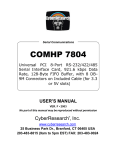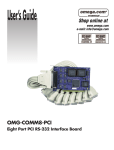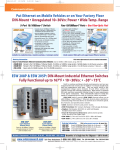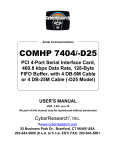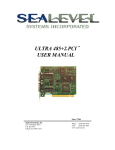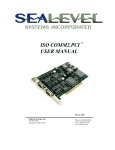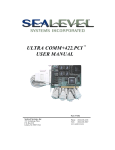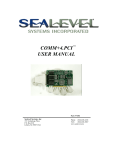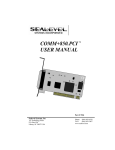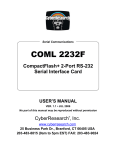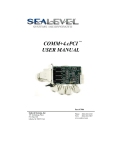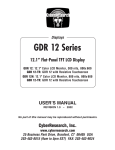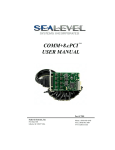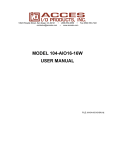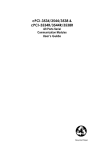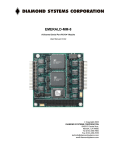Download - CyberResearch
Transcript
® Serial Communications COMHP 7801 Series PCI Serial Interface Card with 8 RS232 Ports & 8 DB-25M or 8 DB-9M Connectors COMHP 7801: 16554 UART COMHP 7801-E: 16854 UART COMHP 7801-X: 16C950 UART USER’S MANUAL VER. 1.1 • 2001 No part of this manual may be reproduced without permission ® CyberResearch , Inc. www.cyberresearch.com 25 Business Park Dr., Branford, CT 06405 USA 203-483-8815 (9am to 5pm EST) FAX: 203-483-9024 ©Copyright 2001 CyberResearch, Inc. All Rights Reserved. The information in this document is subject to change without prior notice in order to improve reliability, design, and function and does not represent a commitment on the part of CyberResearch, Inc. In no event will CyberResearch, Inc. be liable for direct, indirect, special, incidental, or consequential damages arising out of the use of or inability to use the product or documentation, even if advised of the possibility of such damages. This document contains proprietary information protected by copyright. All rights are reserved. No part of this manual may be reproduced by any mechanical, electronic, or other means in any form without prior written permission of CyberResearch, Inc. TRADEMARKS “CyberResearch” and “COMHP 7801” are trademarks of CyberResearch, Inc. Other product names mentioned herein are used for identification purposes only and may be trademarks and/or registered trademarks of their respective companies. • NOTICE • CyberResearch, Inc. does not authorize any CyberResearch product for use in life support systems, medical equipment, and/or medical devices without the written approval of the President of CyberResearch, Inc. Life support devices and systems are devices or systems which are intended for surgical implantation into the body, or to support or sustain life and whose failure to perform can be reasonably expected to result in injury. Other medical equipment includes devices used for monitoring, data acquisition, modification, or notification purposes in relation to to life support, life sustaining, or vital statistic recording. CyberResearch products are not designed with the components required, are not subject to the testing required, and are not submitted to the certification required to ensure a level of reliability appropriate for the treatment and diagnosis of humans. CyberResearch COMHP 7801 Page i Contents INTRODUCTION ..................................................................... 1 OVERVIEW .................................................................................. 1 WHAT’S INCLUDED ..................................................................... 1 CARD SETUP ......................................................................... 2 CLOCK MODES............................................................................ 2 BAUD RATES AND DIVISORS FOR THE ‘DIV1’ MODE....................... 3 ADDRESS AND IRQ SELECTION .................................................... 3 INSTALLATION ...................................................................... 4 OPERATING SYSTEM INSTALLATION ............................................. 4 For Windows Users ................................................................. 4 Other Operating Systems......................................................... 4 SYSTEM INSTALLATION ............................................................... 4 TECHNICAL DESCRIPTION .................................................... 5 CONNECTOR PIN ASSIGNMENTS ................................................... 5 DB-25 (RS-232 DTE) (DB25 MALE).................................. 5 DB-9 (EIA-574 DTE) (DB9 MALE) .................................... 5 DB-78 CONNECTOR PIN ASSIGNMENTS (DB78 FEMALE) ... 6 SPECIFICATIONS ................................................................... 7 ENVIRONMENTAL SPECIFICATIONS ............................................... 7 POWER CONSUMPTION ................................................................ 7 MEAN TIME BETWEEN FAILURES (MTBF).................................... 7 PHYSICAL DIMENSIONS ............................................................... 7 APPENDIX A - TROUBLESHOOTING ...................................... 8 PCI COM NUMBER SELECTION IN WINDOWS 95 .............. 9 APPENDIX B - HOW TO GET ASSISTANCE .......................... 10 APPENDIX C - ELECTRICAL INTERFACE ............................ 11 RS-232..................................................................................... 11 APPENDIX D - ASYNCHRONOUS COMMUNICATIONS .......... 12 APPENDIX E - SILK-SCREEN ............................................... 13 APPENDIX F - COMPLIANCE NOTICES ................................ 14 FEDERAL COMMUNICATIONS COMMISSION STATEMENT .............. 14 EMC DIRECTIVE STATEMENT ................................................... 14 WARRANTY ......................................................................... 16 Figures Figure 1 - Clocking Mode ‘Divide By 4’ ............................................... 2 Figure 2 - Clocking Mode ‘Divide By 1’ ............................................... 2 Figure 3 - Asynchronous Communications Bit Diagram .................... 12 Introduction Introduction Overview The CyberResearch COMHP 7801 provides the PC with eight RS-232 asynchronous ports. The COMHP 7801 allows for connection to any device utilizing the RS-232 electrical interface, such as modems, data-entry terminals, and plotters. What’s Included The COMHP 7801 is shipped with the following items. If any of these items is missing or damaged, contact the supplier. • • • • COMHP 7801 Serial I/O Adapter DB-78 to eight DB-25 ‘Spider Cable’ (DB-9 Spider Cable is available) Serial Utility Software User Manual CyberResearch COMHP 7801 Page 1 Intentionally Blank Card Setup Card Setup Clock Modes The COMHP 7801 employs a unique clocking option that allows the end user to select from divide by 4 and divide by 1 clocking modes. This mode is selected at J1. DIV1 DIV4 To select the Baud rates commonly associated with COM: ports (i.e. 2400, 4800, 9600, 19.2, … 115.2K Bps) place the jumper in the divide by 4 mode (silk-screen DIV4). Figure 1 - Clocking Mode ‘Divide By 4’ DIV1 DIV4 To select the maximum data rate (460.8K bps) place the jumper in the divide by 1 (silk-screen DIV1) position. Figure 2 - Clocking Mode ‘Divide By 1’ CyberResearch COMHP 7801 Page 2 Card Setup Baud Rates and Divisors for the ‘Div1’ mode The following table shows some common data rates and the rates you should choose to match them if using the adapter in the ‘Div1’ mode. For this Data Rate 1200 bps 2400 bps 4800 bps 9600 bps 19.2K bps 57.6 K bps 115.2 K bps 230.4K bps 460.8K bps Choose this Data Rate 300 bps 600 bps 1200 bps 2400 bps 4800 bps 14.4K bps 28.8K bps 57.6 K bps 115.2 K bps If your communications package allows the use of Baud rate divisors, choose the appropriate divisor from the following table: For this Data Rate 1200 bps 2400 bps 4800 bps 9600 bps 19.2K bps 38.4K bps 57.6K bps 115.2K bps 230.4K bps 460.8K bps Choose this Divisor 384 192 96 48 24 12 8 4 2 1 Address and IRQ selection The COMHP 7801 is automatically assigned I/O addresses and IRQs by your motherboard BIOS. Only the I/O address may be modified by the user. Adding or removing other hardware may change the assignment of I/O addresses and IRQs. CyberResearch COMHP 7801 Page 3 Installation Installation Operating System Installation For Windows Users Start by choosing Install Software at the beginning of the CD. Choose Asynchronous COM: Port Software, SeaCOM. Other Operating Systems Refer to the appropriate section of the Serial Utilities Software. System Installation The COMHP 7801 can be installed in any of the PCI expansion slots and contains a single jumper strap that must be set for proper operation. Please see the Card Setup section of the manual for information on this jumper. 1. 2. 3. 4. 5. 6. 7. Turn off PC power. Disconnect the power cord. Remove the PC case cover. Locate an available PCI slot and remove the blank metal slot cover. Gently insert the COMHP 7801 into the slot. Make sure that the adapter is seated properly. Replace the screw. Replace the cover. Connect the power cord. Installation is complete. CyberResearch COMHP 7801 Page 4 Intentionally Blank Technical Description Technical Description The COMHP 7801 utilizes the 16C554 UART. This chip features programmable baud rate, data format, interrupt control and a 16-byte input and output FIFO, and is functionally 4 16C550 UARTs. A full array of advanced UARTS is also available for this card. Contact CyberResearch for more information. Connector Pin Assignments DB-25 (RS-232 DTE) Signal GND TD RTS DTR RD CTS DSR DCD RI Name Ground Transmit Data Request To Send Data Terminal Ready Receive Data Clear To Send Data Set Ready Data Carrier Detect Ring Indicator DB-9 (EIA-574 DTE) Signal GND TD RTS DTR RD CTS DSR DCD RI (DB25 MALE) Pin # 7 2 4 20 3 5 6 8 22 Mode Output Output Output Input Input Input Input Input (DB9 MALE) Name Ground Transmit Data Request To Send Data Terminal Ready Receive Data Clear To Send Data Set Ready Data Carrier Detect Ring Indicator Pin # 5 3 7 4 2 8 6 1 9 Mode Output Output Output Input Input Input Input Input Technical Note: Please terminate any control signals that are not going to be used. The most common way to do this is connect RTS to CTS and RI. Also, connect DCD to DTR and DSR. Terminating these pins, if not used, will help insure you get the best performance from your adapter. CyberResearch COMHP 7801 Page 5 Technical Description DB-78 Connector Pin Assignments Port # TD RD RTS CTS DTR DSR DCD RI GND 1 36 37 17 16 35 18 38 15 34 2 12 11 31 32 13 30 10 33 14 CyberResearch COMHP 7801 3 27 28 8 7 26 9 29 6 25 4 3 2 22 23 4 21 1 24 5 (DB78 FEMALE) 5 75 76 56 55 74 57 77 54 73 6 51 50 70 71 52 69 49 72 53 7 66 67 47 46 65 48 68 45 64 8 42 41 61 62 43 60 40 63 44 Page 6 Specifications Specifications Environmental Specifications Specification Temperature Range Humidity Range Operating 0º to 50º C (32º to 122º F) 10 to 90% R.H. Non-Condensing Storage -20º to 70º C (-4º to 158º F) 10 to 90% R.H. Non-Condensing Power Consumption Supply line Rating +12 VDC 60 mA -12 VDC 100 mA +5 VDC 295 mA Mean Time Between Failures (MTBF) Greater than 150,000 hours. (Calculated) Physical Dimensions Board length Board Height including Goldfingers Board Height excluding Goldfingers CyberResearch COMHP 7801 5.650 inches 3.8 inches 3.475 inches (14.351 cm.) (9.652 cm.) (8.827 cm.) Page 7 Intentionally Blank Appendix A - Troubleshooting Appendix A - Troubleshooting Serial Utility test software is supplied with the CyberResearch adapter and will be used in the troubleshooting procedures. By using this software and following these simple steps, most common problems can be eliminated without the need to call Technical Support. 1. Identify all I/O adapters currently installed in your system. This includes your on-board serial ports, controller cards, sound cards etc. The I/O addresses used by these adapters, as well as the IRQ (if any) should be identified. 2. Configure your CyberResearch adapter so that there is no conflict with currently installed adapters. No two adapters can occupy the same I/O address. 3. Make sure the CyberResearch adapter is securely installed in a motherboard slot. 4. When running DOS, Windows 3.x or other operating systems refer to the Serial Utilities software for that operating system and the User Manual to verify that the CyberResearch adapter is configured correctly. The supplied software contains a diagnostic program 'SSD' that runs under DOS and will verify if an adapter is configured properly. This diagnostic program is written with the user in mind and is easy to use. Refer to the DIAG.txt file in the dos\diag directory for detailed instructions on using 'SSD'. 5. For Windows 95/98 and Windows NT, the diagnostic tool 'WinSSD' is installed in the CyberResearch folder on the Start Menu during the setup process. First find the ports using the Device Manager, then use 'WinSSD' to verify that the ports are functional. 6. Always use the CyberResearch diagnostic software when troubleshooting a problem. This will help eliminate any software issues and identify any hardware conflicts. CyberResearch COMHP 7801 Page 8 Appendix A - Troubleshooting PCI COM NUMBER SELECTION IN WINDOWS 95 When installing a multi-port PCI card in Windows 95 the default starting COM: number assigned to the first port will be COM:5 if no COM:5 exists. If there is a COM: 5, 6, etc., the next available COM: number will be assigned to the first port with all additional ports following in ascending order. To change the first two ports so that Windows assigns them COM: 3 and COM: 4 port enumeration double click the Systems icon in control panel or right click on My Computer and choose properties which will bring you to System Properties. Choose the Device Manager tab and double click on the MultiFunction Adapter heading. This will show all the information concerning the CyberResearch adapter. Choose the Resources tab, which will show all resources assigned to the multi-function adapter. Uncheck the Use Automatic Settings box. Notice that with a two port card there will be three input/output, (I/O), ranges listed. With a four port card there will be five input/output, (I/O), ranges listed. The first I/O range is for the PCI bus and should not be changed. The second and third I/O ranges are the ones that need to be changed in order to have those ports enumerated as COM: 3 and COM: 4. Double click on the second I/O range which will allow you to change the address. Highlight the entire I/O range and type: 03e8–03ef for COM: 3. Click OK. Windows will inform you that you have made modifications that may affect other devices. Click OK. Next double click on the third I/O range. Highlight the entire I/O range and type: 02e8–02ef for COM: 4. Again Windows will inform you that you have made modifications that may affect other devices. Click OK. Following these steps will change the COM: number assignments on the first two ports to COM: 3 and 4. CyberResearch COMHP 7801 Page 9 Appendix B - How To Get Assistance Appendix B - How To Get Assistance Please refer to Troubleshooting Guide prior to calling Technical Support. 1. Read this manual thoroughly before attempting to install the adapter in your system. 2. When calling for technical assistance, please have your user manual and current adapter settings. If possible, please have the adapter installed in a computer ready to run diagnostics. 3. CyberResearch maintains a Home page on the Internet. Our home page address is www.cyberresearch.com. The latest software updates, and newest manuals are available via our FTP site that can be accessed from our home page. 4. Technical support is available Monday to Friday from 9:00 a.m. to 5:00 p.m. eastern time. Technical support can be reached at (800) 341-2525. RETURN AUTHORIZATION MUST BE OBTAINED FROM CYBERRESAERCH SYSTEMS BEFORE RETURNED MERCHANDISE WILL BE ACCEPTED. AUTHORIZATION CAN BE OBTAINED BY CALLING CYBERRESEARCH AND REQUESTING A RETURN MERCHANDISE AUTHORIZATION (RMA) NUMBER. CyberResearch COMHP 7801 Page 10 Appendix C - Electrical Interface Appendix C - Electrical Interface RS-232 Quite possibly the most widely used communication standard is RS-232. This implementation has been defined and revised several times and is often referred to as RS-232-C/D/E or EIA/TIA-232-C/D/E. It is defined as “Interface between Data Terminal Equipment and Data Circuit- Terminating Equipment Employing Serial Binary Data Interchange”. The mechanical implementation of RS-232 is on a 25-pin D sub connector. The IBM PC computer defined the RS-232 port on a 9 pin D sub connector and subsequently the EIA/TIA approved this implementation as the EIA/TIA-574 standard. This standard has defined as the “9-Position Non-Synchronous Interface between Data Terminal Equipment and Data Circuit-Terminating Equipment Employing Serial Binary Data Interchange”. Both implementations are in wide spread use and will be referred to as RS-232 in this document. RS-232 is capable of operating at data rates up to 20K bps / 50 ft. The absolute maximum data rate may vary due to line conditions and cable lengths. RS-232 often operates at 38.4K bps over very short distances. The voltage levels defined by RS-232 range from -12 to +12 volts. RS-232 is a single ended or unbalanced interface, meaning that a single electrical signal is compared to a common signal (ground) to determine binary logic states. A voltage of +12 volts (usually +3 to +10 volts) represents a binary 0 (space) and -12 volts (-3 to -10 volts) denote a binary 1 (mark). The RS-232 and the EIA/TIA-574 specification define two types of interface circuits Data Terminal Equipment (DTE) and Data Circuit-Terminating Equipment (DCE). The CyberResearch Adapter is a DTE interface. CyberResearch COMHP 7801 Page 11 Appendix D - Asynchronous Communications Appendix D - Asynchronous Communications Serial data communications implies that individual bits of a character are transmitted consecutively to a receiver that assembles the bits back into a character. Data rate, error checking, handshaking, and character framing (start/stop bits) are pre-defined and must correspond at both the transmitting and receiving ends. Asynchronous communications is the standard means of serial data communication for PC compatibles and PS/2 computers. The original PC was equipped with a communication or COM: port that was designed around an 8250 Universal Asynchronous Receiver Transmitter (UART). This device allows asynchronous serial data to be transferred through a simple and straightforward programming interface. A starting bit followed by a pre-defined number of data bits (5, 6, 7, or 8) defines character boundaries for asynchronous communications. The end of the character is defined by the transmission of a pre-defined number of stop bits (usually 1, 1.5 or 2). An extra bit used for error detection is often appended before the stop bits. Idle state of line Odd, Even 5 to 8 Data Bits or Unused Remain Idle or next start bit 1 P BIT STOP 0 1 1.5 2 Figure 3 - Asynchronous Communications Bit Diagram This special bit is called the parity bit. Parity is a simple method of determining if a data bit has been lost or corrupted during transmission. There are several methods for implementing a parity check to guard against data corruption. Common methods are called (E)ven Parity or (O)dd Parity. Sometimes parity is not used to detect errors on the data stream. This is refereed to as (N)o parity. Because each bit in asynchronous communications is sent consecutively, it is easy to generalize asynchronous communications by stating that each character is wrapped (framed) by pre-defined bits to mark the beginning and end of the serial transmission of the character. The data rate and communication parameters for asynchronous communications have to be the same at both the transmitting and receiving ends. The communication parameters are baud rate, parity, number of data bits per character, and stop bits (i.e. 9600,N,8,1). CyberResearch COMHP 7801 Page 12 Appendix E - Silk-Screen Appendix E - Silk-Screen 3.8" 5.650" 3.475" CyberResearch COMHP 7801 Page 13 Appendix F - Compliance Notices Appendix F - Compliance Notices Federal Communications Commission Statement FCC - This equipment has been tested and found to comply with the limits for Class A digital device, pursuant to Part 15 of the FCC Rules. These limits are designed to provide reasonable protection against harmful interference when the equipment is operated in a commercial environment. This equipment generates, uses, and can radiate radio frequency energy and, if not installed and used in accordance with the instruction manual, may cause harmful interference to radio communications. Operation of this equipment in a residential area is likely to cause harmful interference in such case the user will be required to correct the interference at his own expense. EMC Directive Statement Products bearing the CE Label fulfill the requirements of the EMC directive (89/336/EEC) and of the low-voltage directive (73/23/EEC) issued by the European Commission. To obey these directives, the following European standards must be met: • EN55022 Class A - “Limits and methods of measurement of radio interference characteristics of information technology equipment” • EN50082-1 - “Electromagnetic compatibility - Generic immunity standard” Part 1 : Residential, commercial and light industry • EN60950 (IEC950) - “Safety of information equipment, including electrical business equipment” technology Warning This is a Class A Product. In a domestic environment this product may cause radio interference in which case the user may be required to take adequate measures. Always use cabling provided with this product if possible. If no cable is provided or if an alternate cable is required, use high quality shielded cabling to maintain compliance with FCC/EMC directives. CyberResearch COMHP 7801 Page 14 Product Service Product Service Diagnosis and Debug CyberResearch, Inc. maintains technical support lines staffed by experienced Applications Engineers and Technicians. There is no charge to call and we will return your call promptly if it is received while our lines are busy. Most problems encountered with data acquisition products can be solved over the phone. Signal connections and programming are the two most common sources of difficulty. CyberResearch support personnel can help you solve these problems, especially if you are prepared for the call. To ensure your call’s overall success and expediency: 1) Have the phone close to the PC so you can conveniently and quickly take action that the Applications Engineer might suggest. 2) Be prepared to open your PC, remove boards, report back-switch or jumper settings, and possibly change settings before reinstalling the modules. 3) Have a volt meter handy to take measurements of the signals you are trying to measure as well as the signals on the board, module, or power supply. 4) Isolate problem areas that are not working as you expected. 5) Have the source code to the program you are having trouble with available so that preceding and prerequisite modes can be referenced and discussed. 6) Have the manual at hand. Also have the product’s utility disks and any other relevant disks nearby so programs and version numbers can be checked. Preparation will facilitate the diagnosis procedure, save you time, and avoid repeated calls. Here are a few preliminary actions you can take before you call which may solve some of the more common problems: 1) 2) 3) 4) Check the PC-bus power and any power supply signals. Check the voltage level of the signal between SIGNAL HIGH and SIGNAL LOW, or SIGNAL+ and SIGNAL– . It CANNOT exceed the full scale range of the board. Check the other boards in your PC or modules on the network for address and interrupt conflicts. Refer to the example programs as a baseline for comparing code CyberResearch, Inc x COMHP 7801 Page 15 Warranty Notice Warranty Notice CyberResearch, Inc. warrants that this equipment as furnished will be free from defects in material and workmanship for a period of one year from the confirmed date of purchase by the original buyer and that upon written notice of any such defect, CyberResearch, Inc. will, at its option, repair or replace the defective item under the terms of this warranty, subject to the provisions and specific exclusions listed herein. This warranty shall not apply to equipment that has been previously repaired or altered outside our plant in any way which may, in the judgment of the manufacturer, affect its reliability. Nor will it apply if the equipment has been used in a manner exceeding or inconsistent with its specifications or if the serial number has been removed. CyberResearch, Inc. does not assume any liability for consequential damages as a result from our products uses, and in any event our liability shall not exceed the original selling price of the equipment. The equipment warranty shall constitute the sole and exclusive remedy of any Buyer of Seller equipment and the sole and exclusive liability of the Seller, its successors or assigns, in connection with equipment purchased and in lieu of all other warranties expressed implied or statutory, including, but not limited to, any implied warranty of merchant ability or fitness and all other obligations or liabilities of seller, its successors or assigns. The equipment must be returned postage prepaid. Package it securely and insure it. You will be charged for parts and labor if the warranty period has expired. Returns and RMAs If a CyberResearch product has been diagnosed as being non-functional, is visibly damaged, or must be returned for any other reason, please call for an assigned RMA number. The RMA number is a key piece of information that lets us track and process returned merchandise with the fastest possible turnaround time. PLEASE CALL FOR AN RMA NUMBER! Packages returned without an RMA number will be refused! In most cases, a returned package will be refused at the receiving dock if its contents are not known. The RMA number allows us to reference the history of returned products and determine if they are meeting your application’s requirements. When you call customer service for your RMA number, you will be asked to provide information about the product you are returning, your address, and a contact person at your organization. Please make sure that the RMA number is prominently displayed on the outside of the box. • Thank You • CyberResearch, Inc x COMHP 7801 Page 16 Intentionally Blank

























